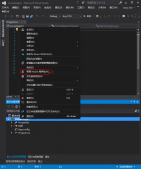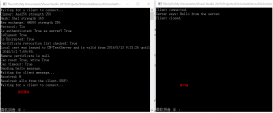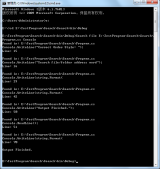在开发中,我们经常会使用IO操作,例如创建,删除文件等操作。在项目中这样的需求也较多,我们也会经常对这些操作进行编码,但是对文件的权限进行设置,这样的操作可能会手动操作,现在介绍一种采用代码动态对文件设置权限的操作。
在对文件进行权限设置在DOtNet中,会采用FileSystemAccessRule类进行文件的权限操作。
1.现在看一下FileSystemAccessRule的实现代码:
|
1
2
3
4
5
6
7
8
9
10
11
12
13
14
15
16
17
18
19
20
21
22
23
24
25
26
27
28
29
30
31
32
33
34
35
36
37
38
39
40
41
42
43
44
45
46
47
48
49
50
51
52
53
54
55
56
57
58
59
60
61
62
63
64
65
66
67
68
69
70
71
72
73
74
75
76
77
78
79
80
81
82
83
84
85
86
87
88
89
90
91
92
93
94
95
96
97
98
99
100
101
102
103
104
105
106
107
108
109
110
111
112
113
114
|
public FileSystemAccessRule( IdentityReference identity, FileSystemRights fileSystemRights, AccessControlType type ) : this( identity, AccessMaskFromRights( fileSystemRights, type ), false, InheritanceFlags.None, PropagationFlags.None, type ) { } public FileSystemAccessRule( String identity, FileSystemRights fileSystemRights, AccessControlType type ) : this( new NTAccount(identity), AccessMaskFromRights( fileSystemRights, type ), false, InheritanceFlags.None, PropagationFlags.None, type ) { } // // Constructor for creating access rules for folder objects // public FileSystemAccessRule( IdentityReference identity, FileSystemRights fileSystemRights, InheritanceFlags inheritanceFlags, PropagationFlags propagationFlags, AccessControlType type ) : this( identity, AccessMaskFromRights( fileSystemRights, type ), false, inheritanceFlags, propagationFlags, type ) { } public FileSystemAccessRule( String identity, FileSystemRights fileSystemRights, InheritanceFlags inheritanceFlags, PropagationFlags propagationFlags, AccessControlType type ) : this( new NTAccount(identity), AccessMaskFromRights( fileSystemRights, type ), false, inheritanceFlags, propagationFlags, type ) { } internal FileSystemAccessRule( IdentityReference identity, int accessMask, bool isInherited, InheritanceFlags inheritanceFlags, PropagationFlags propagationFlags, AccessControlType type ) : base( identity, accessMask, isInherited, inheritanceFlags, propagationFlags, type ) { } #endregion #region Public properties public FileSystemRights FileSystemRights { get { return RightsFromAccessMask( base.AccessMask ); } } internal static int AccessMaskFromRights( FileSystemRights fileSystemRights, AccessControlType controlType ) { if (fileSystemRights < (FileSystemRights) 0 || fileSystemRights > FileSystemRights.FullControl) throw new ArgumentOutOfRangeException("fileSystemRights", Environment.GetResourceString("Argument_InvalidEnumValue", fileSystemRights, "FileSystemRights")); Contract.EndContractBlock(); if (controlType == AccessControlType.Allow) { fileSystemRights |= FileSystemRights.Synchronize; } else if (controlType == AccessControlType.Deny) { if (fileSystemRights != FileSystemRights.FullControl && fileSystemRights != (FileSystemRights.FullControl & ~FileSystemRights.DeleteSubdirectoriesAndFiles)) fileSystemRights &= ~FileSystemRights.Synchronize; } return ( int )fileSystemRights; } internal static FileSystemRights RightsFromAccessMask( int accessMask ) { return ( FileSystemRights )accessMask; } } |
2.由于FileSystemAccessRule继承自AccessRule,现在看一下AccessRule的源码:
|
1
2
3
4
5
6
7
8
9
10
11
12
13
14
15
16
17
18
19
|
/// <summary> /// 表示用户的标识、访问掩码和访问控制类型(允许或拒绝)的组合。<see cref="T:System.Security.AccessControl.AccessRule"/> 对象还包含有关子对象如何继承规则以及如何传播继承的信息。 /// </summary> public abstract class AccessRule : AuthorizationRule { /// <summary> /// 使用指定的值初始化 <see cref="T:System.Security.AccessControl.AccessRule"/> 类的一个新实例。 /// </summary> /// <param name="identity">应用访问规则的标识。此参数必须是可以强制转换为 <see cref="T:System.Security.Principal.SecurityIdentifier"/> 的对象。</param><param name="accessMask">此规则的访问掩码。访问掩码是一个 32 位的匿名位集合,其含义是由每个集成器定义的。</param><param name="isInherited">如果此规则继承自父容器,则为 true。</param><param name="inheritanceFlags">访问规则的继承属性。</param><param name="propagationFlags">继承的访问规则是否自动传播。如果 <paramref name="inheritanceFlags"/> 设置为 <see cref="F:System.Security.AccessControl.InheritanceFlags.None"/>,则将忽略传播标志。</param><param name="type">有效的访问控制类型。</param><exception cref="T:System.ArgumentException"><paramref name="identity"/> 参数的值不能强制转换为 <see cref="T:System.Security.Principal.SecurityIdentifier"/>,或者 <paramref name="type"/> 参数包含无效值。</exception><exception cref="T:System.ArgumentOutOfRangeException"><paramref name="accessMask"/> 参数的值为零,或者 <paramref name="inheritanceFlags"/> 或 <paramref name="propagationFlags"/> 参数包含无法识别的标志值。</exception> protected AccessRule(IdentityReference identity, int accessMask, bool isInherited, InheritanceFlags inheritanceFlags, PropagationFlags propagationFlags, AccessControlType type); /// <summary> /// 获取与此 <see cref="T:System.Security.AccessControl.AccessRule"/> 对象关联的 <see cref="T:System.Security.AccessControl.AccessControlType"/> 对象。 /// </summary> /// /// <returns> /// 与此 <see cref="T:System.Security.AccessControl.AccessRule"/> 对象关联的 <see cref="T:System.Security.AccessControl.AccessControlType"/> 对象。 /// </returns> public AccessControlType AccessControlType { get; } } |
看来DotNet中实现文件权限设置的操作的类,现在提供几个具体的文件设置操作代码:
3.获取目录权限列表:
|
1
2
3
4
5
6
7
8
9
10
11
12
13
14
15
16
17
18
19
20
21
22
23
24
|
/// <summary>/// 获取目录权限列表/// </summary>/// <param name="path">目录的路径。</param>/// <returns>指示目录的权限列表</returns>public IList<FileSystemRights> GetDirectoryPermission(string path){ try { if (!DirectoryExists(path)) return null; IList<FileSystemRights> result = new List<FileSystemRights>(); var dSecurity = Directory.GetAccessControl(new DirectoryInfo(path).FullName); foreach (FileSystemAccessRule rule in dSecurity.GetAccessRules(true, true, typeof(NTAccount))) result.Add(rule.FileSystemRights); return result; } catch (Exception e) { throw new Exception(e.Message, e); }} |
4.设置目录权限
|
1
2
3
4
5
6
7
8
9
10
11
12
13
14
15
16
17
18
19
20
21
22
23
24
25
26
27
28
29
30
31
32
33
34
35
36
37
38
39
40
41
42
43
44
45
46
47
48
|
/// <summary>///设置目录权限/// </summary>/// <param name="path">目录的路径。</param>/// <param name="permission">在目录上设置的权限。</param>/// <returns>指示是否在目录上应用权限的值。</returns>public bool SetDirectoryPermission(string path, FileSystemRights permission){ try { if (!DirectoryExists(path)) return false; var accessRule = new FileSystemAccessRule("Users", permission, InheritanceFlags.None, PropagationFlags.NoPropagateInherit, AccessControlType.Allow); var info = new DirectoryInfo(path); var security = info.GetAccessControl(AccessControlSections.Access); bool result; security.ModifyAccessRule(AccessControlModification.Set, accessRule, out result); if (!result) return false; const InheritanceFlags iFlags = InheritanceFlags.ContainerInherit | InheritanceFlags.ObjectInherit; accessRule = new FileSystemAccessRule("Users", permission, iFlags, PropagationFlags.InheritOnly, AccessControlType.Allow); security.ModifyAccessRule(AccessControlModification.Add, accessRule, out result); if (!result) return false; info.SetAccessControl(security); return true; } catch (Exception e) { throw new Exception(e.Message, e); }} |
5.设置目录权限列表
|
1
2
3
4
5
6
7
8
9
10
11
12
13
14
15
16
17
18
19
20
21
22
23
24
|
/// <summary>/// 设置目录权限列表/// </summary>/// <param name="path">目录的路径。</param>/// <param name="permissions">在目录上设置的权限。</param>/// <returns>指示是否在目录上应用权限的值。</returns>public bool SetDirectoryPermissions(string path, FileSystemRights[] permissions){ try { if (!DirectoryExists(path) || permissions == null || !permissions.Any()) return false; foreach (var permission in permissions) if (!SetDirectoryPermission(path, permission)) return false; return true; } catch (Exception e) { throw new Exception(e.Message, e); }} |
以上就是C#设置文件权限的方法的详细内容,更多关于C#设置文件权限的资料请关注服务器之家其它相关文章!
原文链接:https://cloud.tencent.com/developer/article/1013181
















